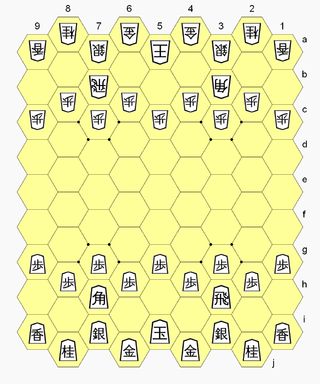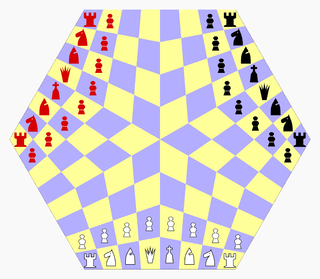
Three-dimensional chess is any chess variant that replaces the two-dimensional board with a three-dimensional array of cells between which the pieces can move. In practical play, this is usually achieved by boards representing different layers being laid out next to each other.

Sittuyin, also known as Burmese chess, is a strategy board game created in Myanmar. It is a direct offspring of the Indian game of chaturanga, which arrived in Myanmar in the 8th century thus it is part of the same family of games such as chess, and shogi. Sit is the modern Burmese word for "army" or "war"; the word sittuyin can be translated as "representation of the four characteristics of army"—chariot, elephant, cavalry and infantry.

Hasami shogi is a variant of shogi. The game has two main variants, and all Hasami variants, unlike other shogi variants, use only one type of piece, and the winning objective is not checkmate. One main variant involves capturing all but one of the opponent's men; the other involves building an unbroken vertical or horizontal chain of five-in-a-row.

Hexagonal chess is a group of chess variants played on boards composed of hexagon cells. The best known is Gliński's variant, played on a symmetric 91-cell hexagonal board.
Sannin shōgi, or in full kokusai sannin shōgi, is a three-person shogi variant invented circa 1930 by Tanigasaki Jisuke and recently revived. It is played on a hexagonal grid of border length 7 with 127 cells. Standard shogi pieces may be used, and the rules for capture, promotion, drops, etc. are mostly similar to standard shogi. While piece movement differs somewhat from standard shogi, especially in the case of the powerful promoted king, the main difference in play is due to the rules for voluntary and mandatory alliance between two of the three players.
Three-player chess is a family of chess variants specially designed for three players. Many variations of three-player chess have been devised. They usually use a non-standard board, for example, a hexagonal or three-sided board that connects the center cells in a special way. The three armies are differentiated usually by color.

Dragonfly is a chess variant invented by Christian Freeling in 1983. There are no queens, and a captured bishop, knight, or rook becomes the property of the capturer, who may play it as their own on a turn to any open square. The board is 7×7 squares, or alternatively a 61-cell hexagon with two additional pawns per side.

Rhombic chess is a chess variant for two players created by Tony Paletta in 1980. The gameboard has an overall hexagonal shape and comprises 72 rhombi in three alternating colors. Each player commands a full set of standard chess pieces.

Triangular chess is a chess variant for two players invented by George R. Dekle Sr. in 1986. The game is played on a hexagon-shaped gameboard comprising 96 triangular cells. Each player commands a full set of chess pieces in addition to three extra pawns and a unicorn.
EuroShogi is a shogi variant invented by Vladimír Pribylinec starting in 2000. The game developed from an early version of chess variant Echos in 1977, leading to Cubic Chess, then later to Cubic Shogi, and finally to EuroShogi. Instead of the classic figures, 18 black and 18 white cubes are used, which are on two opposing sides without symbols. The other two cubes on the opposite sides have one white and one black symbol. The other opposing sides are the same symbols of the opposite color - their promotion is indicated by a circle around symbol. Symbol on top of its mobility. The pieces are placed on the board so that they are oriented towards players without any symbolic surfaces. Plays on a board with 8x8 fields of the same color.

Trishogi is a shogi variant for two players created by George R. Dekle Sr. in 1987. The gameboard comprises 9×10 interlocking triangular cells. The game is in all respects the same as shogi, except that piece moves have been transfigured for the triangular board-cell geometry.

Hexshogi is a shogi variant for two players created by George R. Dekle Sr. in 1986. The gameboard comprises 85 hexagonal cells. The game is in all respects the same as shogi, except that piece moves have been transfigured for the hexagonal board-cell geometry.

Masonic chess is a chess variant invented by George R. Dekle Sr. in 1983. The game is played on a modified chessboard whereby even-numbered ranks are indented to the right—resembling masonry brickwork. The moves of the pieces are adapted to the new geometry; in other respects the game is the same as chess.

Masonic shogi is a shogi variant invented by George R. Dekle Sr. in 1987. The game is played on a modified shogi board whereby alternating ranks are indented to the right—resembling masonry brickwork. The moves of pieces are adapted to the new geometry; in other respects the game is the same as shogi.

Chesquerque is a chess variant invented by George R. Dekle Sr. in 1986. The game is played on a board composed of four Alquerque boards combined into a square. Like Alquerque, pieces are positioned on points of intersection and make their moves along marked lines ; as such, the board comprises a 9×9 grid with 81 positions (points) that pieces can move to.

Tri-chess is the name of a chess variant for three players invented by George R. Dekle Sr. in 1986. The game is played on a board comprising 150 triangular cells. The standard chess pieces are present, minus the queens, and plus the chancellor and cardinal compound fairy pieces per side.

Three-man chess is a chess variant for three players invented by George R. Dekle Sr. in 1984. The game is played on a hexagonal board comprising 96 quadrilateral cells. Each player controls a standard army of chess pieces.

Quatrochess is a chess variant for four players invented by George R. Dekle Sr. in 1986. It is played on a square 14×14 board that excludes the four central squares. Each player controls a standard set of sixteen chess pieces, and additionally nine fairy pieces. The game can be played in partnership or all-versus-all.

Space shogi is a three-dimensional shogi variant invented by George R. Dekle Sr. in 1987. The gamespace comprises nine 9×9 shogi boards stacked vertically. Each player controls a standard set of shogi pieces.


















